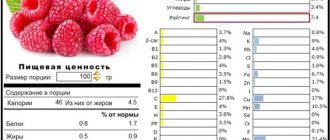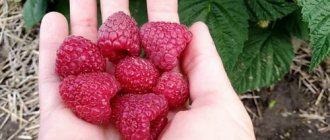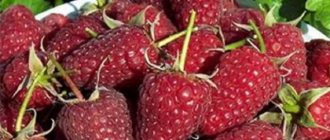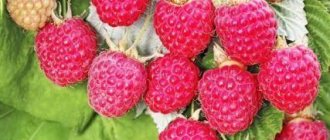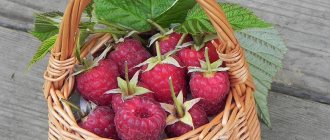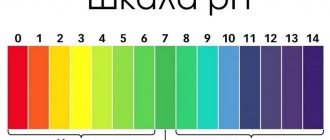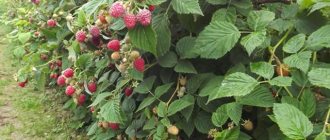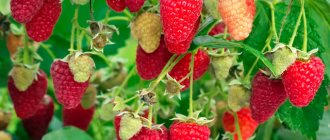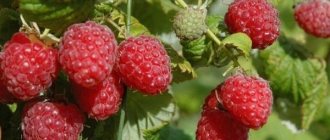Among the cultivated plants living in domestic areas, there are many varieties of foreign selection. Unfortunately, information about the vast majority of these varieties is either extremely scarce or unreliable. The above in no way applies to the remontant raspberry “Polka”, which is often listed by Russian sellers under the name “Polka”.
Raspberry Polka (pictured) has earned great popularity in many countries among amateur gardeners and farmers involved in the commercial production of berries
Its features are well known to gardeners, since the variety is unusually widespread not only here, but also in European countries, where it is considered a kind of standard, both in terms of the consumer qualities of fruits and, if possible, obtaining standardized products on a commercial scale. Let's take a closer look at this wonderful plant and start with its main characteristics:
| Parameter | Characteristic |
| Culture | Garden raspberry (Rubus idaeus L.) |
| Ripening time | Mid-early |
| Type of fruiting | Remontant |
| Productivity | On average up to 2.5 kg per bush per season |
| Berries | Large, weighing 5-6 g (up to 8-10 g), dark red, cone-shaped, smooth, dense |
| Taste qualities | Very high: dessert (sweet-sour, aromatic) |
| Purpose | Universal |
| Features of the plant | The bushes are compact (150-180 cm high); stems are strong, erect, with slight thorniness; the spikes are small and not very hard |
| Shoot formation activity | High |
| Sustainability | The variety is slightly susceptible to most major raspberry diseases and insect pests. |
| Registration in the Federal State Budgetary Institution "State Varietation Commission" | Turned off |
| Originator | Institute of Horticulture and Floriculture in Skierniewice, SDZ (Brzezna, Poland) |
Cultivation history
Remontant Raspberry Polka is an achievement of Polish selection. The variety was obtained by Jan Danek in 1993 at the Institute of Horticulture and Floriculture in Brzezn by pollination by Otm Bliss and line P89141. After testing, it was presented in 2003 at the international Fruit Focus exhibition in Berlin. Since then, Polka has been the leader among remontant varieties for industrial plantings in Poland, Great Britain and many other countries.
Raspberry Polka was bred by Polish breeders and has been a leader in the berry market for a quarter of a century.
What are the advantages and disadvantages?
Raspberries of the Polka variety have the following advantages:
- the taste of the berries is recognized as a standard;
- raspberries are transportable and suitable for industrial-scale cultivation;
- high productivity;
- the fruits do not fall from the bush;
- increased resistance to common diseases and pests.
The crop does not tolerate frost and drought well. Therefore, the plant must be covered before winter and watered abundantly in summer. If planting is carried out in depleted soil, in order to obtain a sufficient harvest, you will need to constantly feed the raspberries.
Description of the variety
The mid-season variety ripens in late July - early August. The fruiting period is long, about 3 months. Summer residents, leaving part of the shoots for next year, due to the double harvest, have the opportunity to feast on fragrant raspberries from the beginning of summer to the end of autumn. On an industrial scale, in order not to subject the plants to excessive stress, all bushes are cut off and only the main crop is harvested. The berry comes to the market when many varieties have already fruited. This allows not only to provide the consumer with fresh vitamin products, but also to bring good profits to the farmer.
A long fruiting period allows you to harvest a record amount of harvest
Unlike ordinary types, remontant raspberries begin to bear fruit in the first year of planting. The harvest can be harvested twice per season, because not only two-year-old shoots bear fruit, but also one-year-old shoots.
A special feature of remontant raspberries is their ability to ripen even when frost occurs. After all, this is truly a miracle: Polka’s berries, even when exposed to a slight frost of -1–2°C, ripen, despite the weak frost resistance of the variety. Farmers are also attracted by its high productivity; compared to Hercules, Polyana Polka is a clear favorite. The average yield is 3.5 kg/m2, but the figures can be much higher: in England, 12 tons of large, beautiful berries were collected from 1 hectare. But the main advantage is the great taste of Polka raspberries, which causes a real boom.
Polka berries are beautiful, with dense juicy pulp and dessert taste
Another advantage of this remontant variety is that there is not a single berry with a wormhole on the bushes. Fruit ripening occurs in late summer, when the flight of harmful insects ends, and the raspberry beetle goes into the soil until spring.
Reviews from gardeners
Anastasia, Moscow region: “I chose the variety based on reviews on one of the forums. Initially, I planted it unsuccessfully - in partial shade. There were few berries, and they had a bland taste. After transplanting, the raspberries have become fresher, and now we collect 5-6 kg from the bush.”
Ivan, Ryazan: “Polka has been growing in my dacha for the 6th year now. I like that the berries ripen gradually and can be eaten fresh from July until almost frost. I won’t say that the taste is purely sweet, there is acidity, especially after the rains.”
Maria, Volgograd: “I grow Polka for sale because the berries are dense and not particularly juicy. To maximize the flavor, you need to pick the berries only after they are fully ripe, when they are burgundy. If you pick them red, the berries are a bit bland.”
Rate this post
Characteristics of raspberry Polka
This is a medium-sized shrub, not exceeding 2 m in height. The stems are erect, strong, with weakly pronounced thorns. A stable bush with a powerful root system does not lie down even under the weight of ripe berries, which makes it possible to do without additional support. Shoot formation is average, one seedling produces up to 10 root shoots, which can be used for breeding the variety. A big plus of remontant raspberries is the limited amount of shoots due to the fibrous structure of the root, so the plants do not fill the entire area.
Raspberry Polka grows as a robust shrub 1.5–1.8 m high
Bright red shiny fruits with slight pubescence are collected in clusters of 7–10 pieces. The berries are conical in shape, beautiful, large, up to 3 cm long, with an average weight of 10–12 g, a maximum weight of 15 g, very tasty due to the balanced content of sugar and acid. An unobtrusive light pleasant sourness and a pronounced raspberry aroma emphasize the unique taste of the variety. The drupe is small, the pulp is juicy, dense, not watery, and does not turn sour for a long time, which allows the berries to be preserved in their marketable condition after harvesting and transportation.
The berries are collected in clusters of 7–10 pieces, which is quite a lot
Raspberries grow well both in open and closed ground. At the beginning of the season, shoots grow from the rhizome, on which fruit formations begin to form. Polka is one of the first to ripen on one-year-old branches - fruiting occurs 2 weeks earlier than the Heritage variety.
Polka grows well and bears fruit both in open ground and under a film cover.
Frost resistance is low, it is necessary to cover the stems for the winter. However, when mowing the aboveground part, shelter is not required. Polka is immune to gray rot, a common disease of raspberries, and it is not afraid of spider mites.
Large Polka berries ripen faster than other remontant varieties
Weaknesses include poor tolerance to extreme heat. In the sun, when the air warms up above 35°C, the bush begins to dry out and the berries bake.
The variety is also prone to root rot, root cancer and verticillium wilt. Timely preventive measures and adherence to agricultural practices will help avoid diseases.
Amazing variety
Landing rules
The development of the bush and the quality of the harvest depend on the correct planting of raspberries. Raspberries are planted in early April or autumn. The most favorable time is to plant at the end of September or beginning of October.
Attention! You should choose seedlings consisting of two or three shoots, without spots or cracks.
Polka raspberries take root well in light to medium loam. Good natural light has a positive effect on the taste of berries. You can place the raspberry patch along fences or next to buildings.
Raspberry planting takes place according to a certain order:
- Two weeks before planting, holes are dug with a depth of 0.5 m and a diameter of 0.4 m.
- Leave 0.5 - 1 m between plants, and up to 2 m between rows of bushes.
- Fertilizer is prepared for one square meter of land: 20 kg of manure, 50 g of potassium sulfate, 70 g of superphosphate. The resulting mixture is filled into the holes prepared for raspberries.
- A raspberry seedling is placed in a hole and the root system is straightened. The replacement kidney is placed 5 cm from the surface of the earth.
- The hole is filled with soil, which is trampled down a little.
- A bucket of water is poured under each bush.
- The soil under the raspberries is mulched with straw or peat.
- 0.4 m from the seedling is left above the soil surface.
Caring for raspberries
The remontant variety Polka is more demanding than ordinary raspberries in terms of growing conditions.
Recent Entries
Lilac perennials that are beautiful, compact and do not crowd out other plants Why when buying seedlings you should not take the sellers’ word for it and how to determine the age of the plant using 3 signs Tomato seedlings have turned purple or whitish: why the color has changed and how to save the plants
Watering and loosening
The culture needs regular watering. Extreme heat and drought negatively affect the shape of the fruit and the yield in general. In the hot sun, the berries bake, become deformed, and the bushes wither. The optimal soil moisture for raspberry growth at a depth of 20–30 cm is about 80%. When the moisture content in the soil decreases to 65%, the bushes need to be watered once a week, using a bucket of water per bush. After the end of the season, if there is no rain, it is necessary to carry out moisture-charging irrigation, using 2 buckets per bush.
With regular watering, the foliage will be bright green and the berries will be juicy.
However, excess moisture is detrimental to Polka. Stagnation of water in the soil can cause insufficient oxygen supply to the roots and yellowing of the tops of plants. In this case, stop watering and loosen the soil around the bush.
There are several ways to moisten a berry garden: sprinkling, furrow watering and drip irrigation. Spraying water in the form of droplets is carried out using a hose with a sprayer or rain installations. This method is best used in dry, hot weather: it allows you not only to saturate the leaves, shoots, and soil with moisture, but also to increase air humidity. But sprinkling is not used during the ripening of the berries, so that they do not become sour. When watering along grooves, water is poured into depressions made in the rows or around the bush, and after absorbing the moisture, they must be filled up.
By spraying water over raspberry bushes, you can not only wet the leaves and soil, but also increase air humidity
The most effective way to moisten a berry garden is drip irrigation. Water is supplied under pressure through pipes laid along the rows of raspberries, and through dispensers is supplied directly to the roots of the plants. As a result, the required moisture content is constantly maintained in the soil layer and productivity increases by 30%. In addition, irrigation using a drip system is fully automated and greatly facilitates the work of farmers growing raspberries over large areas.
Drip irrigation of raspberries is carried out using pipes laid along the rows of plants
The moist soil must be loosened to prevent the formation of a soil crust. You should loosen shallowly (7 cm), trying not to touch the fibrous roots that lie close to the surface. Then you need to cover the root zone with mulch. Mulching helps keep the soil moist, which is especially important in areas with insufficient rainfall or infrequent watering. Straw, bark, chopped corn stalks, onion peels, and humus are used as mulching materials.
A layer of mulch improves soil structure, increases its fertility and retains moisture, and in winter protects roots from hypothermia. In addition, mulch prevents the proliferation of harmful insects. Raspberry roots are often damaged by female cockchafers, but after mulching they are not able to penetrate through a layer of straw or bark into the soil to lay larvae there.
Mulch spread around the bushes helps retain moisture and improves soil structure.
Balanced diet
Remontant raspberries need a lot of nutrients. A lack of microelements can be determined by the changed appearance of plants. Developmental delays and yellowing of leaves indicate a lack of nitrogen; dull dark green foliage and weak shoots are a sign of phosphorus deficiency, curling of the leaf blade and the appearance of a dark rim along the edge are symptoms of potassium deficiency.
Nitrogen deficiency can cause raspberry chlorosis
Young bushes at the beginning of the growing season need nitrogen fertilizing. In spring, urea (30 g/m2) is scattered in the root zone. If shoot growth is not intense enough, feed again after 2 weeks. Instead of mineral fertilizers, you can use organic matter: dilute mullein or chicken droppings with water in a ratio of 1:10 and 1:20 and apply 200 ml of nutrient solution under the bush. Nitrogen-containing fertilizers cause an increase in soil acidity, which raspberries do not like. Therefore, after applying such fertilizers, it is useful to sprinkle the soil near the root with 200 g of ash.
Rotted manure is an excellent fertilizer for raspberries.
The root system of remontant raspberries is very sensitive to chlorine; the presence of this element in potassium fertilizers can cause chlorosis of the bush. Therefore, only chlorine-free formulations should be used to feed Polka.
As soon as the berries begin to appear, it is necessary to fertilize with a solution of Nitrophoska (60 g\10 l), Kemira (50 g\10 l) or add dry fertilizer Yagodka (50 g\m2) to the soil. After the end of the season, to restore strength, the raspberries are fed with a phosphorus-potassium mixture (90 g/m2). The organic fertilizer Biohumus, a solution of which (60 ml\10 l) is applied once a month under the root or sprayed onto the bush, heals and increases soil fertility.
Organomineral fertilizer Biohumus accelerates flowering and fruiting, improves the taste of berries
I use infusions of nettles and onion peels as organic nourishment. I pour water into a barrel with chopped nettles, close the lid and let it sit for a week. I filter the liquid, dilute it with water 1:10 and fertilize the raspberries, using a half-liter jar per bush. I infuse onion peel (500 g\10 l) for 10 days and then dilute it with water. Such infusions not only replenish the deficiency of microelements in the soil, but also repel harmful insects.
Nettle is placed in a barrel and filled with water, the nutritious infusion will be ready in a week
Growing on a trellis
Strong, upright Polka bushes do not require additional support. But to unlock the full potential of raspberries, it is advisable to grow them on a trellis. Without fixation, the shoots may fall to the ground under the weight of the harvest or in strong winds, the penetration of light to the berry branches is impaired, and access to the plantings becomes difficult.
You can simply tie a single bush to a peg driven into the ground. If the raspberries are planted in a linear manner, string a wire at a height of 50 cm and 1 m onto poles dug along the row every 3 m and fix the shoots.
When growing raspberries on a trellis, the bushes are better lit and ventilated
Or, pegs are installed on both sides of the bushes and part of the branches of one plant and part of the neighboring one are tied to them at different heights. The advantage of the fan method is that it improves access of air and sunlight to young, vertically growing stems. However, in gardens such a garter is used extremely rarely.
Video: Raspberry Shelf
Preparing for winter
The variety, having low frost resistance, can freeze out in severe frosts, especially in snowless winters. Therefore, at the end of the season, the berry garden must be prepared for wintering. All stems are completely mowed and, after moistening, the root zone is covered with mulch: humus, peat, straw.
If in the next season they plan to harvest twice, only two-year-old shoots are removed, and annual shoots are bent to the ground, pressed with boards or tied to arches installed next to the bushes, and covered with agrofibre on top.
Before frost, annual shoots are bent to the ground and covered with non-woven material.
Bush formation
Pruning remontant raspberries is the most important stage of care. After fruiting at the end of October, all shoots are cut off, leaving three-centimeter stumps. Autumn pruning not only has a beneficial effect on future harvests, but also protects the crop from diseases and pests that can overwinter on the stems.
Remontant raspberries are completely cut off in the fall.
You can remove only old shoots, leaving young ones. In this case, fruit ovaries for the next season will form first on two-year-old and then on one-year-old branches, but the yield will be lower and the berries will be smaller than with the main late-summer fruiting.
Planning to harvest twice, only two-year-old shoots are removed in the fall, and annual shoots are covered for the winter.
In early spring, before the buds open, you should carefully examine the overwintered bush and remove frozen or broken branches. It is also necessary to normalize the shoots, which take up a lot of nutrients, and leave no more than 7–9 branches on the bush.
In May, before flowering begins, the tops of the stems are shortened by 15 cm, which has a positive effect on the yield. Pinching shoots at a later date can delay the ripening of berries.
Pruning and preparation for winter
Culture propagation
The Polka variety can be propagated by seed and vegetative methods. However, the process of growing from seeds is long and labor-intensive, so it is used mainly for selective selection.
It is much easier to propagate raspberries using green cuttings. At the beginning of summer, young shoots no more than 5 cm high are cut off and planted at an angle of 45 degrees on a seedling bed in a greenhouse. In a humid, warm environment, the cuttings will take root within 2 weeks. They should be fed with complex fertilizer and after a week planted in unprotected soil for growing. And only at the end of the season are the strengthened and mature seedlings transplanted to a permanent place.
Raspberries propagate well from green and woody cuttings
Raspberries are also propagated from root cuttings. In the fall, the roots are dug up, cut into 10-centimeter pieces and planted in the garden. Moisten, cover with a layer of mulch, and lay spruce branches on top. In the spring, as soon as the snow melts, fir branches are removed. The area is covered with film until green shoots appear. During the season, the growing shoots are watered and fertilized, and in the fall they are planted in the raspberry field.
Raspberries are easily propagated by root cuttings: their survival rate is 80%
It is easy to propagate the variety by dividing the bush. The dug up shrub along with the root is divided into parts and planted in separate holes. After watering, the tops of the branches are cut off to form side shoots.
Video: propagation of remontant raspberries by roots
Prevention of diseases and pests
Pests rarely attack remontant raspberries, since by the period of late summer fruiting the active life of many insects has already ended. The variety is resistant to gray rot, a dangerous fungal disease that often affects raspberry plantings and leads to the loss of most of the crop. However, under unfavorable conditions, Polka may develop diseases of the root system. Disinfection of planting material and treatments during the growing season will help prevent the development of diseases.
Table: raspberry diseases
| Diseases | Signs | Prevention | Treatment |
| Root cancer | Pathogenic bacteria, being in the soil or on planting material, spread quickly in dry weather. The disease affects the roots and basal areas of the stem. Tumors form on the roots, plants wither, grow poorly, yields decrease, and the berries become less sweet. |
|
|
| Verticillium wilt | Symptoms appear in mid-summer: leaves turn yellow, dry out and fall off, berries become smaller, dry and tasteless. The bark on the stems cracks, the tops of the shoots droop. At the same time, the root remains viable. |
|
|
| Root rot | In conditions of high humidity, the shoots wither, become covered with dark spots at the base, become distorted, and the leaves acquire a reddish tint. The wood under the bark turns brownish-black. Raspberry roots turn brown and rot. |
|
|
Photo gallery: symptoms of cultural diseases
A sign of root cancer is the formation of a tumor on the roots
Verticillium wilt causes yellowing and wilting of foliage
Roots affected by root rot darken and rot.
Table: main raspberry pests
| Pests | Manifestations | Prevention | Measures |
| Chafer | During the mass flight, which coincides with the flowering period, adult individuals damage the buds and eat the leaves. The larvae gnaw at the raspberry roots, which leads to the death of the berry plant. |
| In spring, spray the bushes with a solution of Confidor Maxi (1 g\10 l), Antikhrushch (20 ml\10 l). |
| Raspberry moth | Moth caterpillars attack raspberries in early spring, damaging the swollen buds. Plant development slows down and productivity decreases. The pest overwinters under plant debris and on old stems. |
| Treat the bushes until the buds swell with solutions of lime (1 kg\10 l), Detoil (100 g\10 l), and 1% DDT emulsion. |
| Aphid | In spring, during dry, warm weather, aphids settle on shoots and the undersides of leaves and suck out the juice of young greenery. Affected leaves curl, dry out, buds do not open, and fruit ovaries do not form. |
|
|
Photo gallery: insects damaging raspberries
The cockchafer feeds on lush greenery. The raspberry moth likes to settle in unkempt and unthinned plantings.
Aphids spread quickly in hot, dry weather and literally stick to leaves and shoots
To protect raspberries from aphid invasion, I plant sage, oregano, lavender, and mint next to the berry garden. Spicy plants repel insects with their pungent odors. But I grow nasturtium, mallow and cosmos in another corner of the garden - small parasites really love these flowers.
Sage planted next to a raspberry tree with its strong smell repels harmful insects from berry bushes
During the budding period, you should not use chemicals to prevent toxic substances from getting into the berries. It is safer to use herbal infusions: nettle, chamomile, which are diluted 1:1 with water and sprayed on the plants.
Pest protection
Garden pests can cause significant damage to raspberries. Most often, raspberries attract stem flies, raspberry beetles, gall midges, weevils, and poutine mites. As a result, raspberry leaves, inflorescences, and stems are damaged.
All affected parts of the bush are removed and then burned. The procedure is carried out in spring or autumn. When gall midges appear, raspberry shoots are cut off at the root.
The following measures help prevent pests:
- leave free space between the bushes;
- Raspberries are pruned annually;
- in autumn the soil is dug up;
- During the season, the soil under the raspberries is loosened;
- Weeds that can become a haven for insects are removed.

